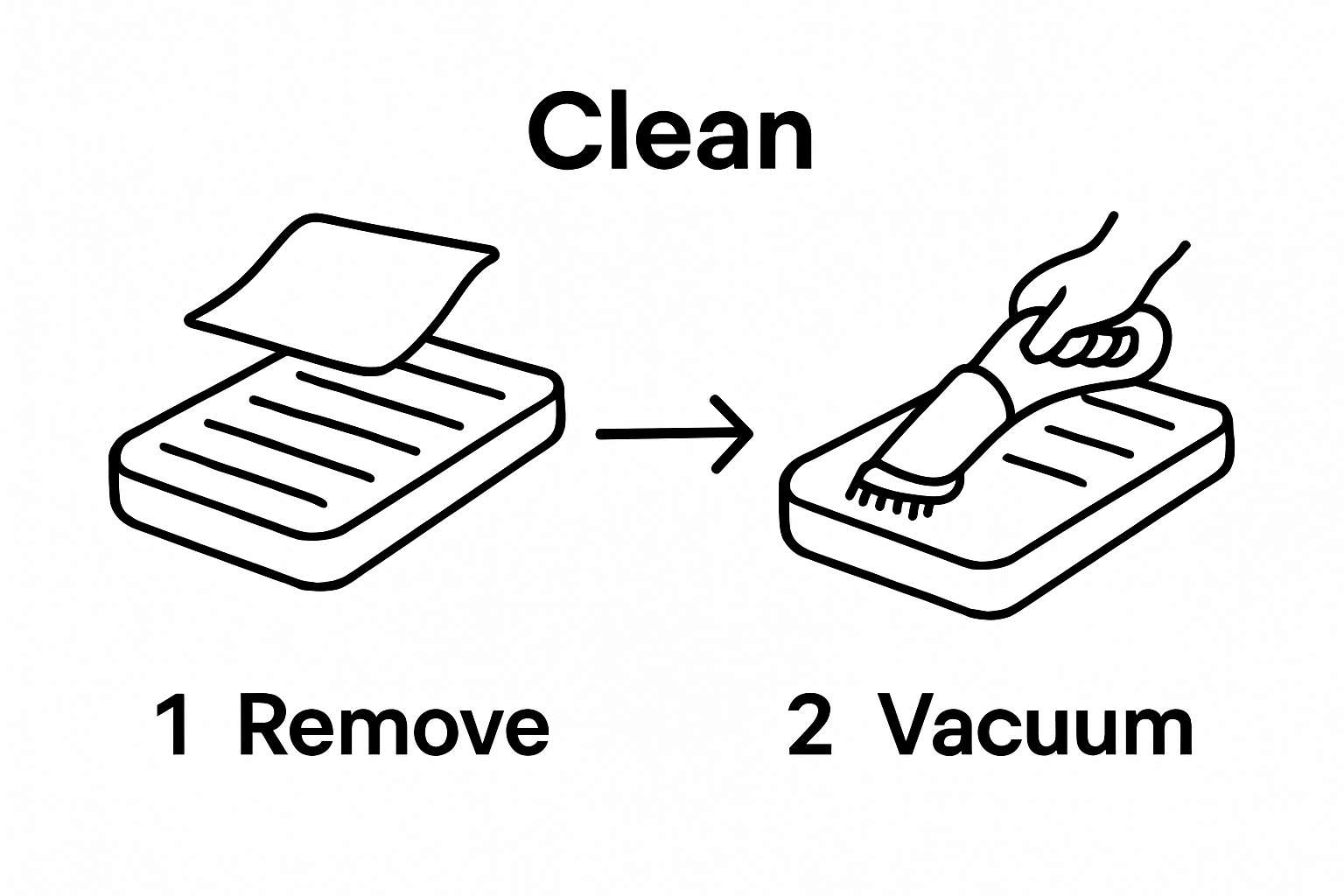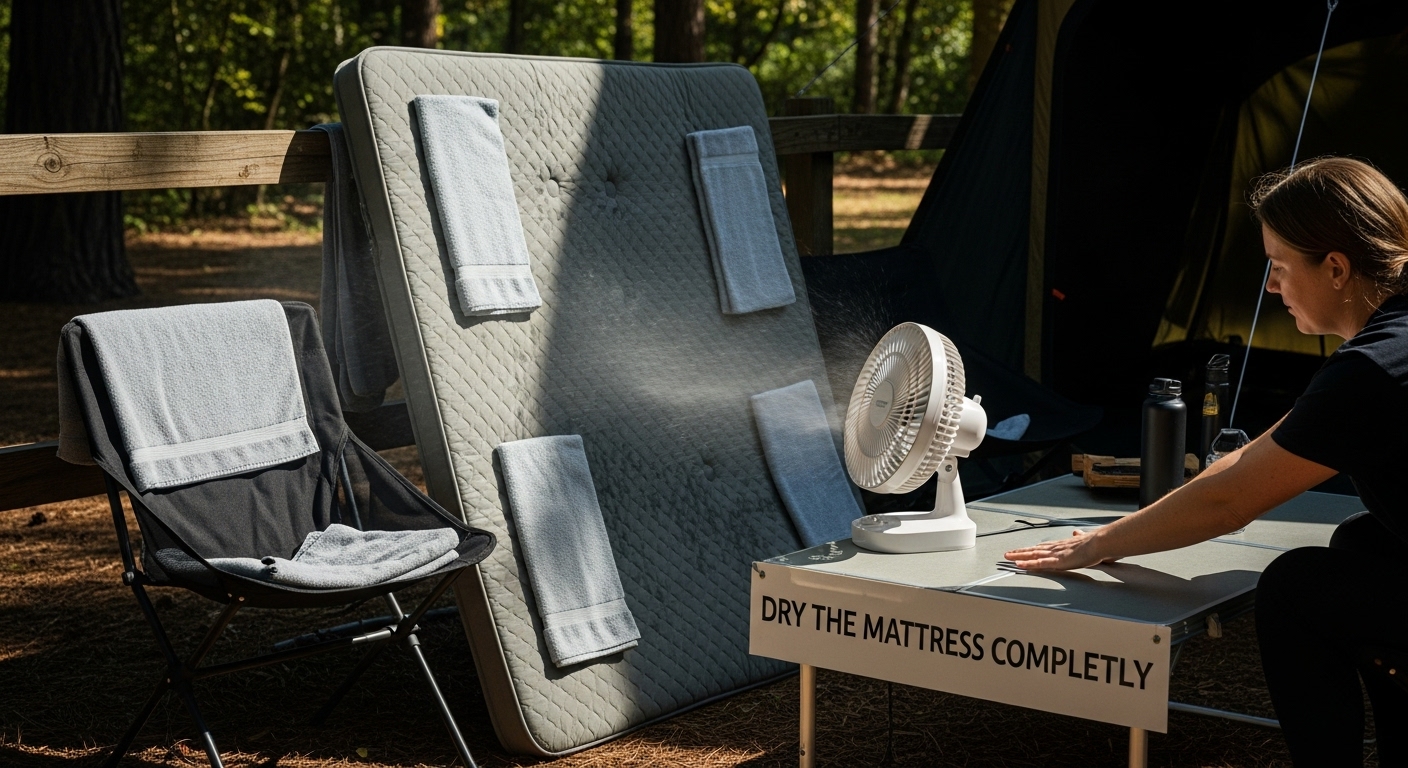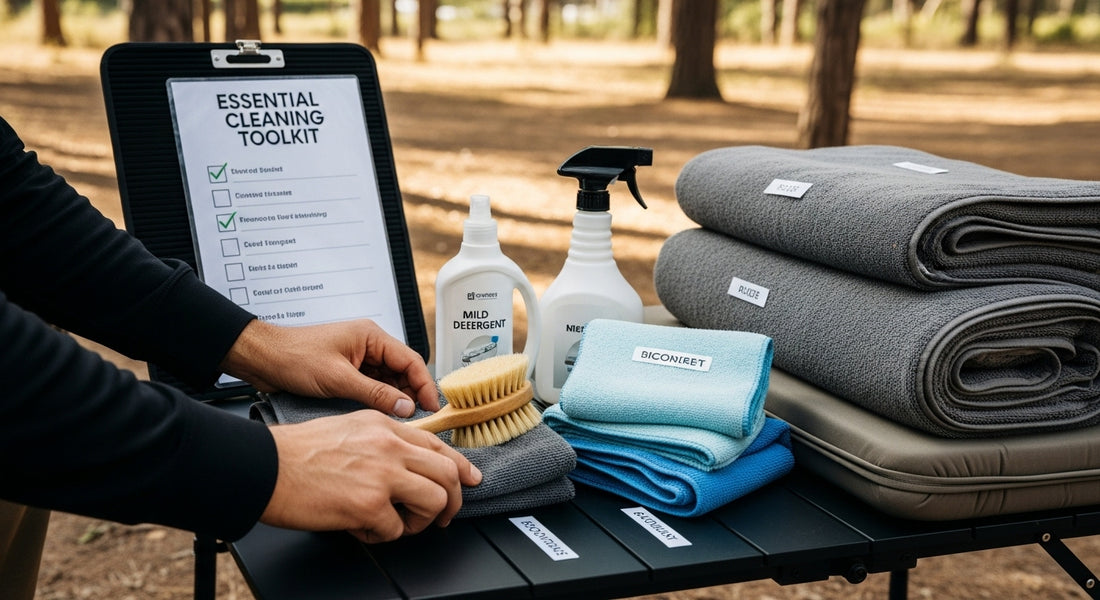Cleaning a camp mattress might sound simple but there is a right way and a wrong way to do it. Some people do not realize that using harsh cleaners like bleach can actually ruin the material and leave you with a mattress that does not last the season. The surprising part is that Consumer Reports warns bleach can damage fabric and memory foam so a gentler approach will keep your mattress in top shape for every adventure.
Table of Contents
- Step 1: Gather Cleaning Materials And Tools
- Step 2: Remove Bedding And Vacuum The Mattress
- Step 3: Create A Cleaning Solution And Apply It
- Step 4: Scrub And Rinse The Mattress Thoroughly
- Step 5: Dry The Mattress Completely Before Use
Quick Summary
| Key Point | Explanation |
|---|---|
| 1. Assemble essential cleaning tools | Gather soft brushes, mild detergents, microfiber cloths, and a spray bottle for effective cleaning. |
| 2. Vacuum mattress before deep cleaning | Remove dust, debris, and allergens by thoroughly vacuuming the mattress on both sides. |
| 3. Create a gentle cleaning solution | Mix mild detergent and warm water; add vinegar for tough stains while maintaining mattress integrity. |
| 4. Scrub and rinse carefully | Use a soft brush to scrub with controlled pressure, then rinse without saturating the mattress. |
| 5. Dry completely before use | Ensure the mattress is fully dry in a well-ventilated space to prevent mold growth and damage. |
Step 1: Gather cleaning materials and tools
Preparing to clean your camp mattress starts with assembling the right materials and tools. A well-organized cleaning approach ensures you tackle dirt, stains, and potential odors effectively without causing damage to your valuable outdoor sleeping surface.
Essential Cleaning Toolkit
Your camp mattress cleaning toolkit requires specific items designed to handle different fabric types and potential outdoor soiling. Start by gathering the following key materials:
- Soft bristle brush
- Mild detergent (preferably unscented)
- White vinegar
- Clean microfiber cloths
- Spray bottle
- Lukewarm water
- Hydrogen peroxide (optional for tough stains)
- Large clean towels
- Waterproof mattress protector (for post cleaning)
Choosing the right cleaning agents matters significantly. Opt for gentle, non-abrasive cleaners that won’t break down mattress fabric or memory foam components. Avoid harsh chemicals like bleach, which can degrade fabric integrity and potentially damage your camping mattress.
Before beginning the cleaning process, inspect your mattress carefully. Check for any existing tears, loose seams, or significant wear that might require professional repair. This initial assessment helps prevent accidentally worsening existing damage during cleaning.
As Consumer Reports recommends for mattress care, selecting appropriate cleaning solutions tailored to your specific mattress material is crucial. Different materials like memory foam, air mattresses, or traditional camping pads require nuanced cleaning approaches.
Prepare a dedicated cleaning workspace that allows full mattress access. Choose a well ventilated area with enough room to maneuver, preferably outdoors or in a spacious, clean environment. Lay down clean towels to protect your cleaning surface and provide a stable area for mattress treatment.
Having all materials prepared beforehand streamlines the entire cleaning process, making it more efficient and reducing the likelihood of interruptions or incomplete cleaning.
Below is a summary table of essential cleaning tools and materials, along with their purposes, for preparing to clean your camp mattress efficiently.
| Item | Purpose |
|---|---|
| Soft bristle brush | Gentle scrubbing without damaging fabric |
| Mild detergent (unscented) | Cleans dirt and stains safely |
| White vinegar | Natural disinfectant, helps remove odors |
| Clean microfiber cloths | Application and blotting of cleaning solution |
| Spray bottle | Even distribution of cleaning mixture |
| Lukewarm water | Base for cleaning and rinsing |
| Hydrogen peroxide (optional) | Tackles tough organic stains |
| Large clean towels | Drying and excess moisture absorption |
| Waterproof mattress protector | Protection after cleaning |
The table below provides an overview of each main step in the camp mattress cleaning process, summarizing key actions and their main objectives.
| Step | Key Action | Main Objective |
|---|---|---|
| 1. Gather cleaning materials and tools | Assemble proper supplies and inspect mattress | Prevent fabric damage and avoid interruptions |
| 2. Remove bedding and vacuum mattress | Strip bedding, shake out debris, and vacuum both sides | Remove loose dirt and allergens |
| 3. Create and apply cleaning solution | Mix gentle detergent, optionally with vinegar or peroxide | Clean stains without harming materials |
| 4. Scrub and rinse mattress thoroughly | Use soft brush for targeted scrubbing, rinse with care | Eliminate deep dirt, avoid residue buildup |
| 5. Dry mattress completely before use | Air dry in ventilation, blot with towels, confirm dryness | Prevent mold and preserve mattress integrity |
Step 2: Remove bedding and vacuum the mattress
Removing bedding and thoroughly vacuuming your camp mattress represents a critical initial cleaning phase that eliminates surface debris, dust, and potential allergens accumulated during outdoor adventures. This preparatory step ensures a more effective deep cleaning process and helps maintain your mattress’s overall hygiene and longevity.
Begin by completely stripping the mattress of all bedding materials. Carefully remove sheets, sleeping bags, mattress covers, and any additional protective layers. Shake out each item outside to dislodge loose dirt, sand, or small debris that might have collected during your camping trip. If your bedding appears particularly soiled, set these items aside for separate washing according to their specific care instructions.
For the actual mattress vacuuming, select a vacuum cleaner with multiple attachments that allow precise and gentle cleaning. Attach the soft brush attachment to prevent damaging the mattress fabric. Start with a methodical approach, moving the vacuum across the entire surface in overlapping strokes. Pay extra attention to seams, corners, and textured areas where dirt and microscopic particles tend to accumulate.
Understand that different mattress materials require slightly varied vacuuming techniques. Memory foam mattresses, for instance, need gentler suction to prevent potential surface damage. Move the vacuum slowly and consistently, allowing the suction to pull out embedded particles without applying excessive pressure.
As Mayo Clinic researchers highlight, thorough vacuuming helps significantly reduce allergen buildup, which is particularly important for outdoor sleeping equipment exposed to variable environments. Take time to vacuum both sides of the mattress if possible, ensuring comprehensive cleaning.
After vacuuming, conduct a visual inspection to verify cleanliness. Look for any remaining visible dirt, check that seams are clean, and ensure no loose particles remain. If you notice persistent dirt patches, you might need to repeat the vacuuming process or prepare for more intensive spot cleaning in subsequent steps.
For campers looking to optimize their outdoor sleeping setup, our Camp Bedding Organization Guide offers additional insights into maintaining clean and well-organized camping sleep systems. The goal of this step is to create a pristine surface ready for targeted stain removal and deeper cleaning techniques.

Step 3: Create a cleaning solution and apply it
Creating the right cleaning solution is a pivotal moment in your camp mattress restoration process. The goal is to develop a gentle yet effective cleaning mixture that removes dirt and stains without compromising the mattress’s structural integrity or specialized materials.
Preparing the ideal cleaning solution requires precise ingredient proportions and careful mixing. Begin by selecting a large, clean spray bottle that allows for even distribution. For most camp mattresses, a simple yet powerful cleaning solution combines mild detergent with lukewarm water. Mix approximately one tablespoon of gentle, unscented liquid detergent with two cups of lukewarm water. If dealing with more stubborn stains, add a quarter cup of white vinegar to the mixture, which provides natural disinfecting properties without harsh chemicals.
Be cautious about solution concentration. Too much detergent can leave residue that attracts additional dirt, while too little might prove ineffective against embedded grime. Gently swirl the bottle to combine ingredients, avoiding aggressive shaking that could create excessive soap suds.
For organic or protein-based stains common in outdoor environments, consider a specialized approach. Add a small amount of hydrogen peroxide to your cleaning solution, which helps break down organic matter without bleaching or damaging most fabric types. Always test the solution on a small, inconspicuous area first to ensure color fastness and material compatibility.
Application technique matters as much as the solution itself. Use a clean microfiber cloth or soft sponge to apply the cleaning mixture. Work in gentle, circular motions, avoiding saturating the mattress. The key is light dampness, not soaking. Excess moisture can lead to mold growth or compromise memory foam structures.
As Cleaning Institute experts recommend, targeted spot treatment works best for specific stains. For mud or food-related marks, apply the solution directly to the stained area, allowing it to sit for a few minutes before gently blotting. Never rub aggressively, as this can push stains deeper into the mattress fabric.
After application, allow the mattress to air dry completely in a well-ventilated area. Direct sunlight can provide additional natural disinfection, but avoid prolonged exposure that might fade or damage the mattress material. Use clean towels to blot excess moisture, promoting faster drying and preventing potential water damage.
Remember that different camp mattress materials might require slight variations in this approach. Memory foam, for instance, demands extra care to prevent moisture retention. The goal is a clean, fresh sleeping surface that maintains its original comfort and structural integrity.
Step 4: Scrub and rinse the mattress thoroughly
Scrubbing and rinsing your camp mattress represents a critical phase in the deep cleaning process, transforming your preliminary cleaning efforts into a comprehensive restoration of your outdoor sleeping surface. This step requires precision, patience, and a gentle touch to effectively remove embedded dirt without compromising the mattress’s structural integrity.
Select a soft bristle brush with flexible, non-abrasive bristles that can navigate the mattress surface without causing damage. The brush should allow you to apply gentle pressure while effectively lifting dirt and grime. Begin by working in small, manageable sections, applying your previously prepared cleaning solution with controlled, circular motions. Avoid aggressive scrubbing, which can potentially damage fabric fibers or push stains deeper into the mattress material.
Focus your attention on visibly soiled areas, using slightly more pressure while maintaining a delicate approach. Areas around seams, corners, and textured regions often accumulate more dirt and require extra care. Move the brush in consistent, overlapping strokes to ensure thorough coverage without creating uneven cleaning patterns.
Rinsing becomes equally important as the scrubbing process. Use clean, lukewarm water and a separate soft cloth or sponge to remove all cleaning solution residue. Thoroughly rinse your cleaning cloth between passes to prevent redepositing dirt onto the mattress surface. The goal is complete solution removal without saturating the mattress material.
As American Camp Association experts recommend, use minimal water during the rinsing process. Excessive moisture can compromise memory foam structures or create potential mold growth environments. Blot rather than soak, using clean towels to absorb excess moisture quickly and efficiently.
Pay special attention to potential problem areas. Stubborn stains might require multiple gentle treatment passes. If a particular spot seems resistant, resist the temptation to scrub harder. Instead, reapply your cleaning solution and allow it to sit for a few minutes before gently working it again.
Verify your cleaning effectiveness by conducting a careful visual and tactile inspection. The mattress surface should appear uniformly clean, with no visible soap residue or remaining dirt patches. Run your hand across the surface to ensure a smooth, consistent texture. Any remaining dampness should be minimal and concentrated in specific areas.
The final step involves thorough drying. Position the mattress in a well-ventilated area, preferably with indirect sunlight. Avoid direct, intense sun exposure that could potentially damage the fabric or cause color fading. Use clean, dry towels to blot away any remaining moisture, promoting faster and more even drying.
Step 5: Dry the mattress completely before use
Drying your camp mattress thoroughly represents the final and critically important stage of the cleaning process. Proper drying prevents potential mold growth, eliminates lingering moisture, and ensures your mattress remains in optimal condition for future outdoor adventures.
Choose a well-ventilated location with indirect sunlight for the drying process. Avoid direct, intense sunlight which can potentially damage fabric fibers or cause color fading. If possible, select an area with steady air circulation that allows moisture to evaporate consistently across the entire mattress surface. Outdoor settings with gentle breeze work exceptionally well, provided the environment is clean and free from dust or additional contaminants.
Position the mattress vertically or at a slight angle to maximize air circulation. Use clean, absorbent towels to initially remove excess surface moisture. Press the towels gently against the mattress, allowing them to absorb water without applying excessive pressure. Rotate and replace towels as they become damp to prevent reintroducing moisture back into the fabric.
For memory foam and specialized camping mattresses, drying time can vary significantly. Thicker materials might require 24 to 48 hours of complete air exposure. Monitor the mattress periodically, rotating it to ensure even drying and preventing potential moisture pockets from developing in less accessible areas.
As American Camp Association experts highlight, maintaining proper airflow is crucial during the drying process. Consider using portable fans to accelerate moisture removal, positioning them to create consistent air movement around the entire mattress surface. Oscillating fans work best, providing comprehensive coverage and preventing localized dampness.
Verify the mattress is completely dry through multiple assessment methods. Touch the mattress in multiple locations, paying special attention to seams and corners where moisture might linger. The surface should feel completely dry and return to its original texture. If any area feels cool or slightly damp, continue the drying process before storage or use.
Additional drying tips include occasional gentle compression with clean, dry towels to extract any remaining moisture. Avoid using heat sources like hairdryers or direct sunlight, which can damage specialized mattress materials. The goal is natural, consistent air drying that preserves the mattress’s structural integrity.
Before considering the mattress ready for use, conduct a final inspection. Check for any residual cleaning solution, ensure complete dryness, and confirm the mattress maintains its original shape and resilience. Only when you are completely confident in its thorough dryness should you proceed to store or prepare the mattress for your next camping expedition.

Upgrade Your Outdoor Sleep Experience with Hazli Collection
Struggling to keep your camp mattress clean, comfortable, and ready for adventure? After following each step from our Complete Camp Mattress Cleaning Guide, you realize how much time and effort it takes to maintain a hygienic sleeping surface. Dirt buildup, lingering moisture, and stubborn stains risk not only your comfort but also your health outdoors. Choosing a reliable, quality mattress is essential for hassle-free cleaning and a restful night under the stars.

Say goodbye to endless scrubbing and uncertainty about mattress hygiene. Discover easy-care, high-comfort camping mattresses from Hazli Collection specifically designed to withstand the rigors of outdoor use. Explore our memory foam sleep solutions for a cleaner, more durable camp setup. Ready to experience true outdoor comfort and peace of mind? Visit Hazli Collection now and find the gear that transforms every camping trip into pure relaxation.
Frequently Asked Questions
How do I clean my camp mattress effectively?
To clean your camp mattress, start by stripping it of all bedding and vacuuming the surface. Then create a gentle cleaning solution using mild detergent and water. Scrub the mattress lightly with a soft bristle brush and rinse thoroughly. Finally, allow it to dry completely to prevent mold growth.
What materials do I need to clean a camp mattress?
Essential materials for cleaning a camp mattress include a soft bristle brush, mild detergent, white vinegar, clean microfiber cloths, a spray bottle, lukewarm water, and large clean towels. A waterproof mattress protector is also recommended for post-cleaning.
Can I use bleach to clean my camp mattress?
No, you should avoid using bleach as it can degrade the fabric and compromise the mattress’s integrity. Instead, opt for mild, non-abrasive cleaners that are gentle on materials.
How long does it take for a camp mattress to dry after cleaning?
The drying time for a camp mattress can vary, but it typically takes 24 to 48 hours in a well-ventilated area with indirect sunlight. Ensure that the mattress is completely dry before storing or using it again.

